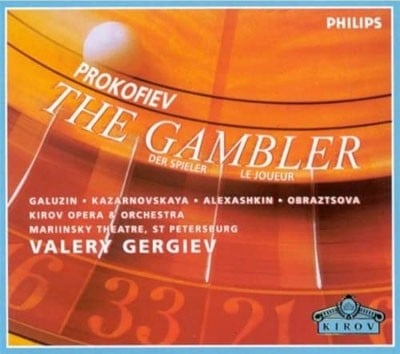The Gambler
op. 24 (1915-17, rev.1927-28)Libretto by the composer after the novel by Dostoevsky (R,E,F,G,I)
Major roles: S,M,A,2T,Bar,B;
minor roles: 2S,2M,A,Tfalsetto,7T,4Bar,7B,mimes
2.picc.2.corA.2.bcl.2.dbn-4.3.3.1-timp.perc:cyms/BD/t.mil/tgl-
2harp-pft-strings
Abbreviations (PDF)
Boosey & Hawkes
Prokofieff’s The Gambler can be viewed as the culmination of the composer’s early radical and experimental period, with its mechanistic ostinatos and febrile energy, perfectly attuned to Dostoyevsky’s study of obsession. The casino, as a potent symbol of unexpected financial gain or ruin, emerges in the final act as the central character of the opera, controlling the destiny of all those that are drawn to the gambling tables, like moths to a flame. Prokofieff intended the work as a reaction against Romantic lyricism, instead preferring to create "an opera in the declamatory style", closer in technique to the stageworks of Dargomyzhsky and Mussorgsky which set musical prose in natural speech rhythms. The Gambler provides an opera company with a potential ensemble showcase, from the two main roles of Alexei and Pauline calling for top rank singing actors, through a gallery of cameo characters, to opportunities for members of the chorus in the casino tableau. From the opening bars the work also announces a crucial role for the orchestra, driving the action forward, and depicting in swirling splashes of colour the fateful spinning of the roulette wheel.

Vladimir Galuzin/Liubov Kazarnovskaya/Sergei Alexashkin/Elena Obraztsova/Kirov Opera/Valery Gergiev
Philips 454 559 (2 CDs)
